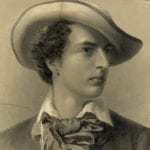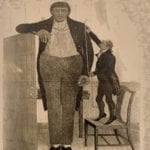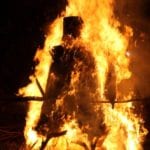 Our World
Our World  Our World
Our World  Pop Culture
Pop Culture 10 Incredible Female Comic Book Artists
 Crime
Crime 10 Terrifying Serial Killers from Centuries Ago
 Technology
Technology 10 Hilariously Over-Engineered Solutions to Simple Problems
 Miscellaneous
Miscellaneous 10 Ironic News Stories Straight out of an Alanis Morissette Song
 Politics
Politics 10 Lesser-Known Far-Right Groups of the 21st Century
 History
History Ten Revealing Facts about Daily Domestic Life in the Old West
 Weird Stuff
Weird Stuff 10 Everyday Products Surprisingly Made by Inmates
 Movies and TV
Movies and TV 10 Actors Dragged out of Retirement for One Key Role
 Creepy
Creepy 10 Lesser-Known Shapeshifter Legends from Around the World
 Our World
Our World 10 Science Facts That Will Change How You Look at the World
 Pop Culture
Pop Culture 10 Incredible Female Comic Book Artists
 Crime
Crime 10 Terrifying Serial Killers from Centuries Ago
Who's Behind Listverse?

Jamie Frater
Head Editor
Jamie founded Listverse due to an insatiable desire to share fascinating, obscure, and bizarre facts. He has been a guest speaker on numerous national radio and television stations and is a five time published author.
More About Us Technology
Technology 10 Hilariously Over-Engineered Solutions to Simple Problems
 Miscellaneous
Miscellaneous 10 Ironic News Stories Straight out of an Alanis Morissette Song
 Politics
Politics 10 Lesser-Known Far-Right Groups of the 21st Century
 History
History Ten Revealing Facts about Daily Domestic Life in the Old West
 Weird Stuff
Weird Stuff 10 Everyday Products Surprisingly Made by Inmates
 Movies and TV
Movies and TV 10 Actors Dragged out of Retirement for One Key Role
 Creepy
Creepy 10 Lesser-Known Shapeshifter Legends from Around the World
10 Stages in the History of Drinking Parties
Some people drink regularly, and others don’t, but just about everyone has a story about going out and getting loaded with friends, either at a party or at the bar, and of the wild things you did and the crazy things you said. Hopefully, you made it home in one piece, and if you didn’t, hopefully, you learned your lesson.
But either way, you’re not alone, as accounts of revelrous partying spurred on by beer, wine, and/or spirits have been historically documented all across the world. And as far back as prehistoric times, drinking most likely went on at least within the vicinity of wild grapevines (or apple trees and berry bushes), which naturally ferment.
So let’s take a look at some high-spirited, party-hardy moments and themes throughout history that have made an impact on the ongoing, popular pastime of group inebriation.
Related: 10 Quenching Legends, Myths, And Stories Involving Alcohol
10 Tipsy Birds and Bees
Alcoholic fermentation occurs when certain microorganisms (yeast, for the most part) break down glucose and fructose in natural, sugar-rich substrates such as fruit and berries, producing ethanol and carbon dioxide. This is a natural process that has gone on since, well, before the advent of man. However, while plants love the carbon dioxide, the animal kingdom seems to prefer the ethanol—hands down!
The Bohemian waxwing birds of northern forests in Eurasia and North America fill their bellies the best they can while flying south for the winter. They sometimes feast together in great flocks on fallen fruits and berries upon the ground, which, if they’ve fermented, are the all-natural version of Jello shots. Though most of the birds handle their buzz pretty well, many of them choose to overindulge each year, staggering through the sky on drunken wings and slamming into buildings and each other.
And honey bees in Australia often drink from fermented nectar in the summer, which sometimes leads to large, disorganized swarms. However, when and if they make it back to the hive, they’re barred entry and usually killed by guard bees protecting the purity of the honey. Also in Australia reside the red-collared lorikeet parrots, which like to tie one on with fermented flower nectar from the Weeping Boer-bean tree each December, often falling from the branches to the ground. One should never exceed his limit while perched upon a tree limb.
Some partying critters fit in quite well in the modern world, where humans manufacture the drug ethanol in larger quantities and stronger potencies than rotting berries and tainted nectar possibly could. The vervet monkeys on the island of St. Kitts in the Caribbean have acquired a taste for alcohol. In gangs, they raid local bars along the beach for beer and colorful cocktails left unattended, after which they have their own private party drinking top-shelf among the tops of palm trees.
And back in 1974, in West Bengal, India, a herd of about one-hundred and fifty elephants drank large quantities of moonshine after breaking into a still. They became so drunk that they caroused about in a rampage, trampling twenty huts and seven concrete buildings, killing five people. Talk about a morning after full of regrets and apologies![1]
9 Stumbling Through Ancient History
The first apple might have gotten Adam and Eve thrown out of the Garden of Eden, but if they were anything like their descendants with the second and third apples, they likely made cider…
In 2018 archaeologists digging up a Stone Age cave in Israel came across the ruins of a prehistoric brewery 13,000 years old. Whoever owned it was probably one very popular hunter-gatherer. They feel the beer produced in this brewery was likely consumed at ritual feasts (another name for a party) held by the Natufian people, and its discovery seems to support the long-standing hypothesis that beer brewing might have been part of the reason cereal crops were initially planted in the southern Levant.
The Natufians lived during the Late Epipalaeolithic period, which saw early advances in agriculture, particularly cereal grains, and the fact that they had already achieved an understanding of beer making at this point in time suggests that one of their motivations for laying seed was to make more beer and thereby have more ritual feasts (or parties).
Moving ahead a good 10,000 years…an ancient Egyptian inscription from 2200 BC teaches “the mouth of a perfectly contented man is filled with beer.” How accommodating for men of that age that they got to celebrate the Tekh Festival each year, which pretty much mandated inebriation for its participants in honor of Hathor, the goddess of fertility, agriculture, and on a less wholesome note, drunkenness. But the Bast Festival in honor of pregnancy and childbirth was certainly one for the girls, as they were encouraged to drink, dance, and show everyone their genitals. This was an unladylike behavior that was not customary at other festivals in ancient Egypt, although it probably did encourage pregnancy and childbirth.
It seems that the ancient Greeks were the first to hold drinking parties just for the sake of drinking and not necessarily held on a day of religious observance. They were called symposia, and they were an all-male event held by aristocrats, though often young women were in attendance as entertainment. The Greek symposium was an affair of intellectual conversation and flamboyant ostentation, and as the wine flowed, the party could get pretty rowdy. A favorite drinking game was to sling wine across the floor, either trying to form specific letters or to hit target objects. And if the images depicted on Greek vases and jugs are accurate, there were a lot of erotic encounters with hired women—and sometimes men.
One of the most famous symposia was held in 416 BC, the theme of which was moderation, as most of the attendees were hungover from a symposium held the previous evening. The great philosopher Socrates attended the party, and he gave a rather long speech which concluded at sunrise amid a room full of men asleep on the floor. Historians will never know for sure if those men had chosen intemperance after all or if perhaps Socrates had been just a tad bit long-winded.[2]
8 The Wedding at Cana Controversy
“There was a marriage in Cana of Galilee: and the mother of Jesus was there. And Jesus also was invited, and his disciples, to the marriage. And the wine failing, the mother of Jesus saith to him: They have no wine. And Jesus saith to her: Woman, what is that to me and to thee? my hour is not yet come. His mother saith to the waiters: Whatsoever he shall say to you, do ye. Now there were set there six waterpots of stone…Jesus saith to them: Fill the waterpots with water…And Jesus saith to them: Draw out now, and carry to the chief steward of the feast…And when the chief steward had tasted the water made wine…the chief steward calleth the bridegroom, And saith to him: Every man at first setteth forth good wine…But thou hast kept the good wine until now. This beginning of miracles did Jesus in Cana of Galilee…” (John 2:1-11 DR).
There are many hard-core Christians who believe Jesus would never have created such a morally destructive substance as wine from water, for after all elsewhere in the Bible, it says, “You shall not drink wine nor any thing that may make drunk, thou nor thy sons…” (Lev. 10:9 DR). Such zealots believe that the water was turned into grape juice, unfermented, and in all fairness, they make an interesting argument due to a series of translations.
The Greek word “oinos” is used in both the Old and New Testaments for the word wine (or grape juice), and though “oinos” generally does denote the alcoholic version, technically, it can mean specifically juice from freshly-stomped grapes. To further confuse things, the Greek “oinos” is a translation of two Hebrew words, “tirosh” and “yayin,” both of which have a similar ambiguity. But most historians would disagree, as, without refrigeration, it was difficult for the Hebrews to store any type of fruit juice without natural fermentation. Therefore, the primary reason grapes were stomped was to make wine.
And educated theologians would argue that even though many try to inject conservative Christian values into New Testament stories, the wedding at Cana took place very early in Jesus’ ministry, as evidenced by His words “mine hour is not yet come.” This was truly a Jewish wedding, and wine was a staple at such festivals.
Or ask any wine enthusiast what the governor of the feast (probably some sort of headwaiter) meant when he said, “Every man at the beginning doth set forth good wine…but thou hast kept the good wine until now.” He was referring to the practice of offering finer vintages at the start of a party to intoxicate and numb the guests’ tongues before slipping them the crappy stuff. His comment would have made no sense if he hadn’t just tasted actual wine. And anyone with common sense would point out that Mary wouldn’t have flagged down her son just to replenish unfermented grape juice. People only panic at a party when the booze runs out, not the soft drinks!
So the votes are in—Jesus was not only a guest at a drinking party, but He also contributed to the vibe. But He grew up learning the words of the prophet Isaiah, after all, who once preached “let us eat and drink; for tomorrow we shall die” (Isa. 22:13 DR).[3]
7 The Romans Threw One Hell of a Party
The Roman banquet parties, called convivia, were adapted from the Greek symposia, but they were much less philosophical and tended to be more politically driven. Unlike the symposium, respectable women were allowed at these banquets, though they were not allowed to recline as the men. Also, unlike the Greek parties, where heavy drinking generally started after the meal, the convivium offered wine from start to finish.
The Roman Empire extended from Northern Africa throughout the Mediterranean and included parts of Western Asia, so they had quite the assortment of vittles at these banquets. Naked waiters would walk about with trays of wild sow’s udders, African ostrich, and tongue of peacock. Wine was generously served to reclining men in togas who gorged themselves on delicacies and drink without any notion of moderation, often up until they vomited, after which they’d continue gorging.
And conspiratorial intrigue was widespread at these affairs. For example, at a banquet in 375 BC, a drunken Cleitus the Black called out his commanding officer, a likewise drunk Alexander the Great, who threw an apple at him in return. Unfortunately for Cleitus, who wouldn’t shut up, the apple was followed by a javelin through the heart. And when in 54 AD Emperor Claudius died the day after presiding over a banquet, it was rumored that his fourth wife, Agrippina, poisoned him with tainted mushrooms due to political motivations for her son, Nero. He would later show his thanks by having her assassinated five years later.
But the wildest of convivia didn’t hold a candle to the Bacchanalia festivals in honor of Bacchus, the god of wine, ecstasy, and fertility (often in that order). These wild parties under the guise of fertility festivals hit Rome about 200 BC. They included not just drinking and dancing but also violent escapades such as sexual initiation, buggery, and the occasional murder to keep things jumping. And women outnumbered men at these carnal carnivals three to one! But these celebrants, which numbered in the thousands, were considered to be a cult, and they were looked down upon by many of the more conservative citizens of Rome.
The wild antics of this crazy cult worsened, and in 186 BC, just a few short years after its inception into Rome, the Senate launched an investigation into Bacchanalia, fearing insurrection. According to the Roman historian Livy, the Senate took control of the cult, dismantling the existing chapters and mandating strict guidelines for future gatherings. In the process, 7,000 participants were arrested, most of them executed. Now, you know a party might have gotten a tad bit out of hand when thousands of attendees end up in the clink![4]
6 When Fermentation Meets Distillation
The origin of distillation is uncertain, but historians agree it predates written history. The technique was initially used to produce perfumes and medicinals, and early “stills” even purified seawater. Then some ancient entrepreneur decided to throw in some wine to see what happened—and he got brandy! Then someone threw in some grain mash to see what might pop out…and the fine art of partying was significantly upgraded.
That’s a very condensed (no pun intended) explanation of distillation, and much of the wheres and whens of its arrival unto society is based upon assumption. It’s believed that traveling monks brought into Ireland the art of distilling perfumes around 1000 AD, and within a hundred years or so, the good ol’ Irish boys had figured out how to morph the procedure into making spirits. Early versions of their whiskey were unaged and flavored with herbs, but over the centuries, the technique further morphed into what is known today extendedly as Irish whiskey.
Public houses, or pubs (the opposite of “private” houses which sold memberships to the elite), have also been around in Ireland for about a thousand years, and they were meeting places where the working class could sit together and converse—and to drink! Irish pubs have been a source of suds and songs for centuries, and some existing establishments are absolutely ancient!
Take Sean’s Bar, for instance, in the town of Athlone in County Westmeath, which reportedly has been in operation since 900 AD. Though the building has been renovated many times, still the customers can feel a sense of history when they walk in upon a floor covered with woodchips. It’s intimidating to imagine the extent of partying that went on in this pub for the past 1,100 years and how many overworked laborers sat back at the end of the day and relaxed with a glass of mead, beer, wine, or fine Irish whiskey. If only the walls of Sean’s Bar—made of wattle, wicker, horsehair, and clay—could talk.
And jumping a bit to the east…the British got their hands on gin for the first time while in Holland (its birthplace) fighting the Thirty Years’ War against the Spanish in the seventeenth century. During the reign of King William III (1650-1702), the popularity of gin became more popular than beer for the working class—mainly because it was mass-produced and cheaper. Commoners took to drinking it ravenously, and public “gin and gingerbread” festivals began to pop up in 1731 along the River Thames whenever the weather turned inclement.
These “London Frost Fairs” consisted of tents and stalls peddling hot gin, and the parties were so popular many Londoners welcomed bad weather, often bringing the revelry upon the frozen river. But public behavior was getting so out of hand, and gin-related deaths were so much on the rise that the government stepped in five years later and imposed a distiller’s license at the exorbitant price of 50 pounds. And it worked like a charm, as only two licenses had been purchased a full seven years later.
And over in North and Eastern Europe, distillation took a different turn, as Russia, Poland, and Sweden each developed the concept of vodka separately during the Middle Ages. Vodka mainly consists of ethanol and water, though trace elements often linger in the taste, and “little water,” which is what vodka means in Russian, can be made from a large variety of sources, including cereal grains, potatoes, rice, grapes, sugar beets, honey, maple sap or just plain sugar water.
As such, the Russians have embraced it as their national drink, and today, it is served at every type of celebration, commemoration, and festive function you could possibly think of, which explains one of their favorite toasts: May we always have a reason for a party! However, the stalwart Russians have stringent rules for drinking vodka at parties: the drink is best served with bread; one should always down their glass in one gulp; and when the host opens a new bottle, he should throw away the cap. He won’t be needing it again.[5]
5 Pre-Columbian Socials
There is a common misconception that alcoholic beverages were nonexistent in the Americas before Europeans arrived, and though it wasn’t universal, there was definitely some pre-1492 imbibing among the Indigenous people. Due to their isolation from the rest of the world, the technique of distillation was mostly unheard of before the white man brought it with him. Still, many pre-Columbian cultures certainly took note of natural fermentation…
As a matter of fact, the ancient Mesoamericans seemed to ferment anything they could get their hands on that was fermentable. However, the beverages they produced were generally used communally in spiritual ceremonies rather than individually. For thousands of years, the Mayans made alcoholic drinks from honey, corn, pineapples, cacti, and both tree bark and sap, among other local plants.
One of their favorite drinks, balché, made from tree bark, was doubly ingested during rituals for maximum effect—both down the throat as a beverage and up the backside as an enema. This was a bit extreme for the conquering conquistadors, who put a stop to such ribald revelry. And the Olmec people (1100-900 BC) produced a weak alcoholic drink called cacao wine for their ceremonies, which was probably the earliest consumption of the same tree from which we make chocolate. And to this day, chocolate and wine make for the start of a mighty fine party.
And to the north, the Native Americans inhabiting what would someday become the United States also indulged in fermented beverages, although usage varied from tribe to tribe and was generally more common in regions where agriculture had developed. The Yuman-speaking tribes located south of the Grand Canyon would host parties with neighboring villages where they served wine made from the saguaro fruit, which would encourage dancing, the celebration of alliances, and the formation of plans to attack their enemies.
The Pueblo Indians along the Rio Grande made a drink from fermented grain to celebrate the end of winter in their yearly “bringing-the-buds-to-life” ceremony—sort of a very early spring break gathering. Likewise, the woodland Huron tribe of the Northeast took great pains to incur beer for their tribal feasts, leaving unripe corn in a pool of stagnant water for several months before declaring the resulting gruel ready for consumption. Mouth-watering!
Historians have also noted that many tribes across North America had traditionally forbidden the consumption of alcohol, but that only proves that they had sampled it at one time and found it to be corrupting.[6]
4 Pilgrims and Patriots Raising Their Glasses
The first Puritan ship, the Arabella, set sail to America in 1630, carrying 10,000 gallons of both beer and wine compared to only 3,500 gallons of water. But really, they were only following in the footsteps of the humble Pilgrims who’d set sail ten years earlier…
Contrary to popular belief, the Pilgrims who arrived at Cape Cod in 1620 were actually pretty heavy-drinking people, each of them consuming about a gallon of beer daily. By the time they reached America on the Mayflower, they’d run out of their favorite drink and had to get creative with whatever they could find. Soon after, they’d developed the technique of making beer from corn, spruce branches, and pumpkins, plus also hard cider from apples, among other concoctions.
In 1621, they held a three-day autumn feast with the Wampanoag Indians in honor of the harvest, and though it was reported in the written record of the event that they ate wild turkeys and venison, there is no mention of what they drank. Most historians would agree alcoholic beverages were served as the Pilgrims had no reason to skip the hard stuff at this particular celebration. As a matter of fact, they probably drank twice as much, being that it was a big, long party (which the Wampanoags might have found interesting as they were one of the tribes clueless about fermentation). And being that the time of year was autumn, they would have been washing down their meal with pumpkin beer and hard cider. History repeats itself as four hundred years later, these drinks are making quite the comeback, from fine pumpkin ale (or just about anything pumpkin-tasting from coffee to Gatorade) to delicious craft cider.
Both the Pilgrims and the Puritans were suspicious of drinking plain water, having emigrated from England, where water was often contaminated and unsafe. But fermented beverages, even low in alcohol content, kill harmful bacteria, so that was what they preferred to drink. And they mainly drank beer (which is actually full of nutrients) to the point that each and every meal was practically a kegger!
These were definitely not times when alcohol was solely a 21+ indulgence, and children also had their ration of beer—breakfast, dinner, and supper depending on availability. Of course, when supply was low, they had to drink water, which was actually crystal clear though they still held their suspicions, and milk was for making cheese and butter—not for drinking. This was a time when, if the church elder could smell beer on the breaths of children on the morning of the Sabbath, he knew all was good and well.
And now, moving forward a good hundred and fifty years to the Boston Tea Party on December 16, 1773, which was dubbed as such fifty-odd years later in a series of newspaper articles, the word “party” meaning “party of men.” But apparently, there had been one hell of a pre-party beforehand, as there were reports of men throwing back pints and singing rebellious songs at the Green Dragon Tavern shortly before storming toward the Boston Harbor around midnight.
The unruly mob had refused to listen to Samuel Adams, the protest leader, when he’d ordered them to stop, and they rampaged onto Griffin’s Wharf dressed like Mohawk Indians with blackened faces and deafening war whoops—a group of rowdy dissenters fueled by alcohol and fury! And in their attempt to decry the unfairness of British taxation, they raided three ships privately owned by Americans while vandalizing property owned by the East India Tea company and exported from China. Have a few more, boys… [7]
3 Forbidden Fruit
John Chapman, better known as Johnny Appleseed, traveled back and forth from Pennsylvania through Illinois in the late eighteenth through early nineteenth centuries planting cider apple trees and the medicinal herb dogfennel. It turns out dogfennel is a very invasive, unpleasant weed that is also poisonous. Many of the evangelicals urging temperance in the nineteenth century felt the same about his apple trees.
Alcohol consumption in the U.S. during the 1820s was at an all-time high. While the temperance movement that had formed was already attacking whiskey and other spirits, by the end of the decade, they were going for absolute abstinence and targeting the apple, as hard cider was a popular and affordable drink for the working class. Fanatical activists declared cider to be more dangerous than whiskey as it was weaker in alcohol content, thereby giving the imbiber more time to make mischief and wreak havoc before passing out.
This fervor took a maniacal stance when evangelicals suggested good Christian farmers should burn their orchards rather than inflict their ungodly fruits upon society, and one orchard owner in New Haven, CT, cut down all the trees so that his apples could not “promote intemperance.” And while most apple farmers didn’t actually go so far, this was a time in history when orchards across New England started to become abandoned, the wilderness swallowing them up into obscurity. But inside bars and taverns across the country, people still raised mugs of cool, sweetly-bitter, amber delight to each other, secure (and inebriated) in their right to do so![8]
It would take over one hundred years of activism, debate, and crazed evangelism before they lost that right.
2 Prohibition Was a Blast!
The Eighteenth Amendment was approved by Congress in 1919, and on January 17, 1920, the United States went dry. Shortly afterward, underground drinking clubs popped up everywhere across the country, mostly in urban areas, and they were called speakeasies because patrons were encouraged to whisper a secret password to gain entry, to speak softly once inside so as not to draw attention from the coppers, and to speak carefully of the establishment when in public.
These clubs had a party atmosphere, using music and dancing to lure people in, and for the most part, the men weren’t dancing with each other. Women started going to bars for the first time, and how sophisticated they must have felt, having just been granted to right to vote, as they sipped on their drinks amongst the wild and forbidden feel of the speakeasy!
Color lines were also crossed in many clubs for the first time as blacks and whites both partied together to the lively sound of jazz music. The bathtub gin was supplied by bootleggers whose product often tasted horrible, so bartenders took to mixing it in drink glasses with juice or soda, something new in the country since men customarily had always used shot glasses—and the cocktail was born.
It is estimated that New York had between 30,000 to 100,000 speakeasies that operated during Prohibition. While many of them were backroom joints that left no paper trail, many others made a big impression on the city’s history. For instance, take Chumley’s, a historic pub and one-time speakeasy that opened in Greenwich Village in 1922. The original owner was a socialist activist. It was rumored that the property was once part of the underground railroad, which might explain the secret stairs and trapdoors that helped keep the bootlegged liquor hidden in case of a search by the authorities.
In its heyday, Chumley’s was the stomping grounds for the prominent literary community, with patrons such as Ernest Hemingway and F. Scott Fitzgerald. And the term “86’d” is said to have originated there, as 86 is the street number of the back entrance through which people would flee when the police were coming through the front door. But all good things come to an end, and in 2020, almost a full hundred years after opening as a speakeasy, Chumley’s closed its doors for good, a victim of the pandemic.
And way across the country, hundreds of speakeasies in San Francisco served fine spirits smuggled in from Canada by sea, rather than solely relying on homemade bathtub gin. That was actually quite fitting as the liberal city officials took the concept of Prohibition with a grain of salt, only going through the motions with their enforcement of the new law. The police department basically turned a blind eye to the illegal drinking, thinking it to be a problem for the feds, and when corrupt officers started demanding unnecessary bribes from proprietors, the federal government did indeed step in—although it was the sheriff’s office and the police they were investigating.
The partying patrons, however, didn’t hold much fear of law enforcement, and they looked at the occasional raids as mere inconveniences, often going right back to drinking as soon as the cops left. Even if they spent the night in jail, it made for a colorful anecdote to share with their drinking friends the following evening. Often these clubs had front areas masquerading as soda or candy shops and backrooms for getting plastered, not to mention basement barrooms, secret getaway doors, and even underground tunnels—no two speakeasies were the same! In 1933 Prohibition was repealed, and most of the speakeasies closed, but many are still in operation with historic furnishings and secret passwords for entry. And why not? Prohibition in San Francisco was a blast![9]
1 Boozing It Up Over the Holidays, and There Are Lots of Holidays
Many Americans start the new year, each year, at a party, already half sloshed by the time the ball drops, but hey—there’s always room for champagne. And they’ve got an entire month to recover before the next major holiday—Super Bowl Sunday! While the Big Game isn’t technically a holiday, many people think it should be at least a three-day weekend, as many folks are pretty hungover the Monday after. Football fans spend over a billion dollars on beer each year planning the perfect indoor tailgate party (or kegger in the garage), and often these bashes start the night before. Certainly sounds like a three-day weekend holiday!
And in March, Americans raise their glasses to the Irish (or at least toward Irish whiskey) with enthusiasm that, interestingly enough, surpasses the actual Irish, as St. Patrick’s Day in Ireland is an official church holiday and festive drinking is much more moderate. And come May, we celebrate Mexican heritage with tequila and cerveza in large Cinco de Mayo festivals all across the country. However, in Mexico, the observance is regional and, for the most part, contained to the states of Puebla and Veracruz.
We often fly the flag during the summer months while soaking up the sun and the suds, and both Uncle Sam and the extended brewing industry are thankful. On Memorial Day, we drink ice-cold beer at our barbecues, or we sneak it onto the beach. And on the Fourth of July, colorful cocktails go rather well with fireworks. Of course, by the time Labor Day rolls around in September, we’re so grateful for another day off from work we’ll drink whatever we can get our hands on.
And anyone who truly appreciates hard cider, pumpkin ale, or any type of cranberry cocktail knows that Halloween parties are not just for kids, though often they’re disguised as casual, autumn soirees with a pumpkin or two but no costumes. These types of drinks carry over rather well for formal gatherings also, though if that’s the case, it might not be just the turkey that makes you feel like napping.
Of course, the Christmas parties start while there’s still leftover stuffing in the fridge. Whether it’s a tedious office party, a warm family gathering, or a festive game of dirty Santa, the odds are libations will be served to keep the occasion jolly. In December of 2020, Americans bought 16.3 billion dollars worth of booze; the following month’s sales dropped to 11.3 billion—that makes for 5 billion dollars worth of holiday cheer. And soon enough, another New Year’s Eve comes around. We raise our champagne glasses to toast one another yet again, waiting for that darn ball to drop…and life is good when you’ve got a buzz with your friends.[10]








